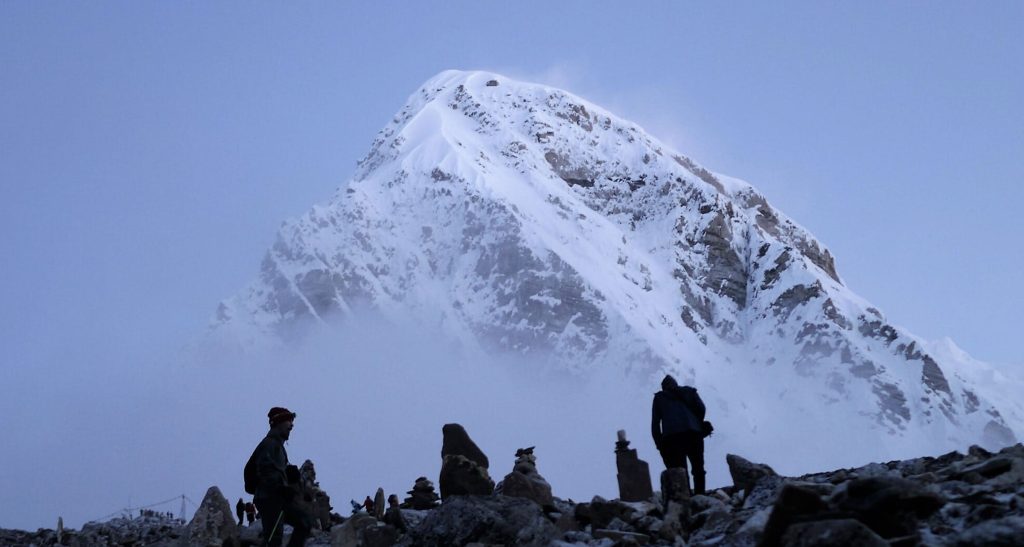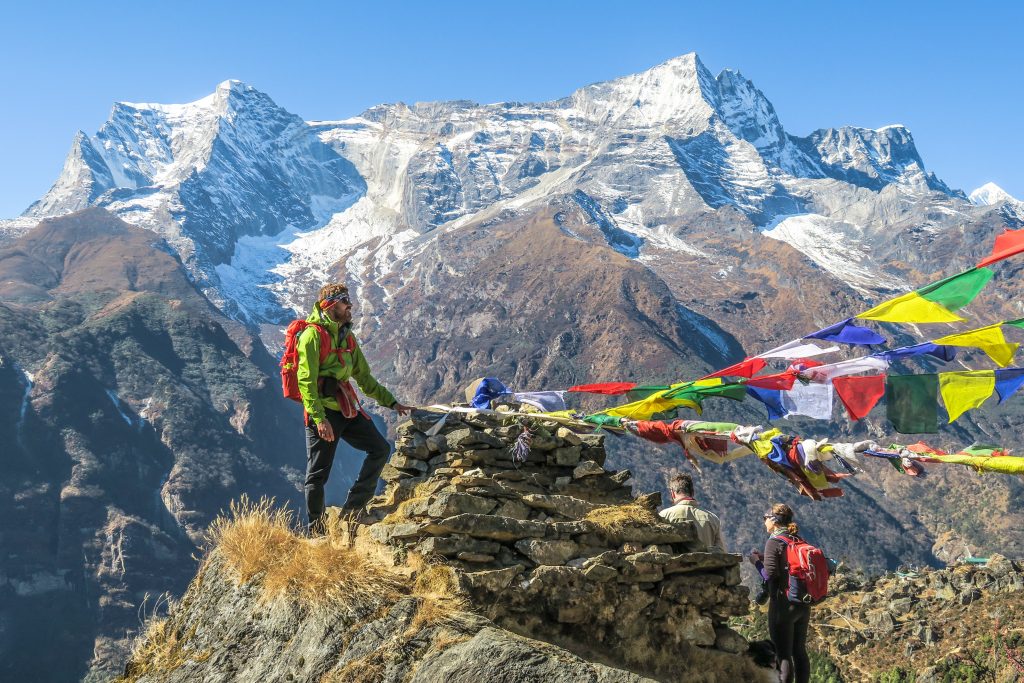The Namche Bazaar to Everest Base Camp trekking route is one of the most popular and iconic treks in the world. It offers breathtaking views of the Himalayan mountains and takes you through some of the most beautiful and remote landscapes on earth.
In this article, we will provide a comprehensive guide to the Namche Bazaar to Everest Base Camp trekking route, including information on the distance, route, cost, difficulty level, safety tips, and much more. We will also address some of the common questions and keywords related to this trek, such as the closest town to Everest Base Camp, the best route for the Everest Base Camp trek, and whether a beginner can go to Everest Base Camp. By the end of this article, you will have a better understanding of what it takes to complete this challenging trek and be prepared for an unforgettable adventure in the Himalayas.
The Namche Bazaar to Everest Base Camp Trekking Route
The Namche Bazaar to Everest Base Camp trekking route is a challenging and rewarding journey that takes you through the heart of the Khumbu region in Nepal. The trek starts in Lukla, a small town situated at an altitude of 2,800 meters, and takes you through the famous Sherpa village of Namche Bazaar. From Namche Bazaar, the trek continues to the village of Tengboche, famous for its ancient monastery and stunning views of Mount Everest.
The route then takes you through Dingboche, Lobuche, and Gorak Shep, before finally reaching the Everest Base Camp. The trek back is via the same route or can be via the alternative route through the famous viewpoint of Kalapatthar, offering stunning views of Mount Everest and the surrounding peaks.
Distance and Duration
The total distance covered on the Namche Bazaar to Everest Base Camp trek is approximately 130 kilometers (81 miles), round trip. The duration of the trek can vary depending on the route, pace, and acclimatization schedule. Generally, it takes around 12 to 14 days to complete the trek, including rest days for acclimatization.
Difficulty Level
The Namche Bazaar to Everest Base Camp trekking route is considered a challenging trek, as it involves high altitude trekking and several steep ascents and descents. Trekkers need to be physically fit and mentally prepared for the trek. Proper acclimatization is essential to prevent altitude sickness, which can be life-threatening.
Cost of the Trek
The cost of the Namche Bazaar to Everest Base Camp trek can vary depending on various factors such as the duration of the trek, route, and package. On average, the cost can range from $1,200 to $3,000 per person, excluding international airfare.
Common Questions and Keywords
Can You See Mount Everest from Namche Bazaar?
Yes, you can see Mount Everest from Namche Bazaar, which is situated at an altitude of 3,440 meters (11,286 feet). Trekkers can enjoy stunning views of Mount Everest and other surrounding peaks from various viewpoints in Namche Bazaar.
What is the Closest Town to Everest Base Camp?
The closest town to Everest Base Camp is Gorak Shep, situated at an altitude of 5,164 meters (16,942 feet). It is the last settlement before reaching the base camp and offers basic accommodation and facilities.
Is Namche Bazaar Worth Visiting?
Yes, Namche Bazaar is definitely worth visiting, as it is one of the most vibrant and picturesque villages in the Khumbu region. It offers a glimpse into the unique Sherpa culture, with its colorful prayer flags, traditional houses, and bustling markets.
Can a Beginner Go to Everest Base Camp?
Yes, a beginner can go to Everest Base Camp, but they need to be physically fit and mentally prepared for the trek. It is recommended to have some prior trekking experience and to undergo proper training and preparation before embarking on the trek.
Are There Shops at Everest Base Camp?
No, there are no shops at Everest Base Camp, as it is a temporary campsite used by mountaineers and trekkers during the climbing season. Trekkers need to carry all the necessary supplies and equipment with them during the trek.
Which Route is Best for Everest Base Camp Trek?
The best route for the Everest Base Camp trek depends on various factors such as duration, fitness level, and personal preference. The two most popular routes are the classic route via Nam
As you continue your trek, you’ll pass through Tengboche, Dingboche, and Gorak Shep before finally reaching Everest Base Camp. The trek can be strenuous, with varying altitudes and rugged terrain, but the stunning views and the feeling of accomplishment upon reaching your destination make it all worthwhile.
Now that we have a general idea of the trek, let’s answer some common questions that trekkers may have before embarking on this journey.
How much will it cost to go to Everest Base Camp?
The cost of the trek can vary greatly depending on a number of factors such as the time of year, the trekking agency, the length of the trek, and the level of luxury or basicness desired. On average, a basic 12-16 day trek can cost anywhere from $1,000 to $1,500 USD. However, for a more luxurious trek with added amenities, the cost can be upwards of $5,000 USD.
Is it hard to walk to Everest Base Camp?
The trek to Everest Base Camp is considered to be moderate to difficult in terms of physical exertion. The varying altitudes, rugged terrain, and changing weather conditions can make it challenging. However, with proper physical conditioning and acclimatization, anyone with a moderate level of fitness can accomplish this trek.
Can you see Everest from Namche Bazaar?
Yes, on a clear day, you can see the majestic peak of Everest from Namche Bazaar. In fact, many trekkers take a rest day in Namche Bazaar to acclimatize and explore the town’s unique culture and stunning views.
What is the closest town to Everest Base Camp?
Gorak Shep is the closest town to Everest Base Camp. It is situated at an altitude of 5,164 meters and serves as the final resting spot for trekkers before their ascent to the base camp.
How long is the trek from Lukla to Everest Base Camp?
The trek from Lukla to Everest Base Camp is approximately 65 kilometers or 40 miles long. The trek generally takes 12-16 days, depending on the itinerary and pace of the trekker.
Is Namche Bazaar worth visiting?
Yes, Namche Bazaar is definitely worth visiting. It is a unique town with a rich cultural heritage and stunning views of the surrounding peaks. Many trekkers choose to spend a rest day in Namche Bazaar to acclimatize and explore the town’s markets, restaurants, and museums.
Can a beginner go to Everest Base Camp?
Yes, a beginner with proper physical conditioning and acclimatization can go to Everest Base Camp. It is recommended that beginners take a slower pace and allow for extra rest days to properly acclimatize to the higher altitudes.
Are there shops at Everest Base Camp?
Yes, there are a few shops at Everest Base Camp that sell basic supplies such as snacks, water, and souvenirs.
Which route is best for Everest Base Camp Trek?
The most popular and well-established route for the Everest Base Camp Trek is the route that goes through Namche Bazaar. It offers stunning views and a chance to experience the unique culture of the region.
Is it hard to breathe at Everest Base Camp?
At an altitude of 5,364 meters, the air is thinner and oxygen levels are lower at Everest Base Camp. This can make breathing more difficult, but with proper acclimatization and the use of medication such as Diamox, most trekkers can adjust to the altitude.
Is there electricity in Namche Bazaar?
Yes, there is electricity in Namche Bazaar, but it can be unreliable at times. Many teahouses and lodges have backup generators
Another popular route is the Gokyo Lakes trek, which offers stunning views of the turquoise Gokyo Lakes, the Ngozumpa glacier, and the surrounding Himalayan peaks. This trek also takes you to the Everest Base Camp and includes a hike up Gokyo Ri, a peak that offers a breathtaking panoramic view of the entire Everest region.
Overall, whether you choose the classic Namche Bazaar to Everest Base Camp trek or the Gokyo Lakes trek, you are in for an unforgettable experience that will leave you with a newfound appreciation for the beauty and majesty of the Himalayas.
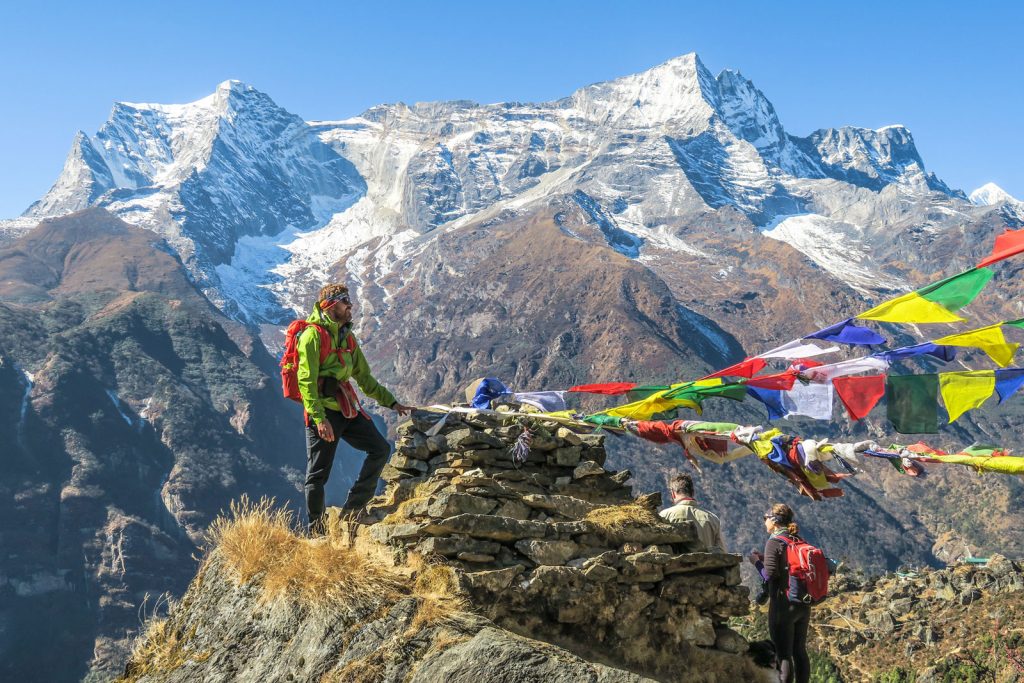
Everest Base Camp Trekking Permits
One of the most important things to keep in mind when planning your Everest Base Camp trek is that you will need to obtain permits before you can embark on your journey. These permits are necessary to regulate the number of visitors to the area and to help preserve the natural beauty and cultural heritage of the region.
Explanation of Permits Required for the Trek
There are two permits that you will need to obtain for the Everest Base Camp trek: the Sagarmatha National Park Entry Permit and the TIMS (Trekkers’ Information Management System) card.
The Sagarmatha National Park Entry Permit is issued by the Nepal Department of National Parks and Wildlife Conservation and is required for entry into the Sagarmatha National Park, which includes the Everest Base Camp trekking route. The permit costs USD 30 per person and is valid for multiple entries for a period of 30 days.
The TIMS card is issued by the Trekking Agencies Association of Nepal (TAAN) and is a way for the government to ensure the safety and security of trekkers on the trail. The card costs USD 20 per person for independent trekkers and USD 10 per person for trekkers traveling with a registered trekking agency. The card is valid for the entire duration of your trek.
Cost of Permits
The total cost of the permits required for the Everest Base Camp trek is USD 50 per person for independent trekkers and USD 40 per person for trekkers traveling with a registered trekking agency. Keep in mind that these costs are in addition to the cost of your trekking package and other expenses such as accommodations, meals, and equipment.
Information about Obtaining Permits
You can obtain your Sagarmatha National Park Entry Permit and TIMS card either through a registered trekking agency or by visiting the Nepal Tourism Board in Kathmandu. If you choose to obtain the permits yourself, you will need to bring your passport, two passport-sized photos, and the permit fee in cash.
If you choose to go through a registered trekking agency, they will typically take care of obtaining the permits for you as part of their package. This can save you time and hassle, and ensure that you have all the necessary permits before starting your trek.
Conclusion:
Obtaining the necessary permits for the Everest Base Camp trek is an important part of the planning process. By understanding the requirements and costs associated with the permits, you can ensure that you are fully prepared for your journey. Whether you choose to obtain the permits yourself or through a registered trekking agency, make sure that you have all the necessary documentation before embarking on your trek.
Everest Base Camp Trekking Packages
If you’re planning to go on the Everest Base Camp trek, you’ll have a number of package options to choose from. These packages usually include transportation, accommodation, meals, permits, and a guide. The cost of the package will depend on the duration of the trek, the level of service you require, and the season in which you’ll be trekking.
Overview of Everest Base Camp Trekking Packages
There are a variety of trekking packages available for Everest Base Camp. Some packages are more basic and budget-friendly, while others are more luxurious and expensive. Most packages will include the following:
- Transportation: This usually includes a flight from Kathmandu to Lukla, which is the starting point for the trek. Some packages also include transportation back to Kathmandu.
- Accommodation: This includes a mix of teahouse lodges and camping. Teahouses are basic guesthouses that provide a bed and meals. Camping is usually included for those who want a more adventurous experience.
- Meals: Packages usually include three meals a day, which are provided by the teahouses or camping staff.
- Permits: The permits required for the trek, including the Sagarmatha National Park permit and the TIMS card.
- Guide: Most packages include a guide, who will provide information about the trail, the culture, and the environment. A guide is especially important for those who are not experienced trekkers.
Comparison of Different Packages
When choosing an Everest Base Camp trekking package, it’s important to compare different options to find the one that best suits your needs and budget. Some factors to consider include:
- Duration of the trek: Most packages range from 12 to 16 days, but some may be longer or shorter.
- Level of service: Basic packages will be less expensive but offer fewer amenities, while luxury packages will be more expensive but provide more comfort and service.
- Season: Peak season (October and November) is the most expensive time to trek, while the off-season (June to August) is less expensive.
- Inclusions: Some packages may include extras like helicopter evacuation insurance or additional sightseeing tours.
By comparing different packages, you can find the one that best fits your needs and budget. It’s important to read reviews and ask questions before booking a package to ensure that you’re getting what you expect.
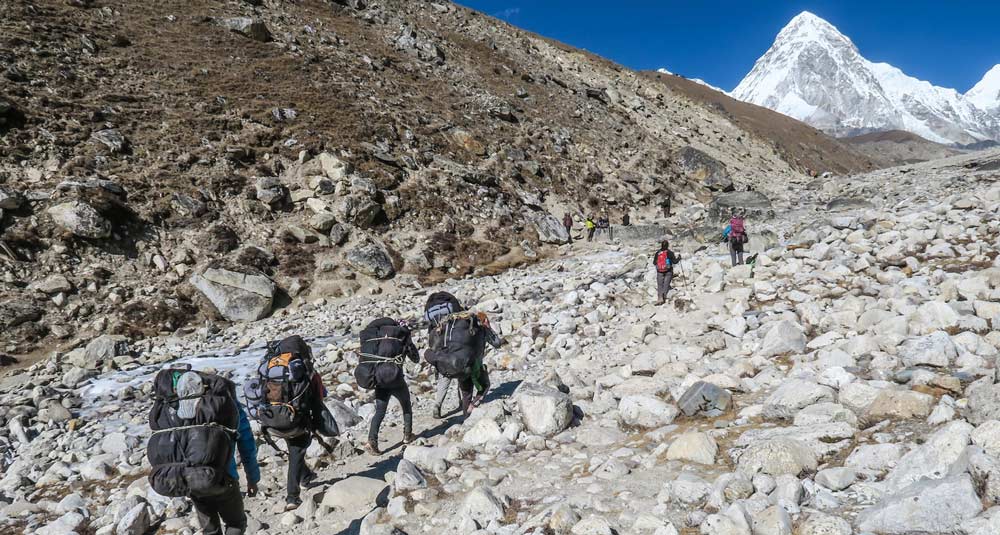
Difficulty Level of the Everest Base Camp Trek
Everest Base Camp Trek is one of the most challenging treks in the world. The trek requires a good level of physical fitness and mental preparation. The trek is not only physically demanding, but also mentally challenging due to the high altitude, harsh weather conditions, and long hours of walking. However, with proper preparation and training, anyone can complete the trek.
Level of Difficulty
The difficulty level of the Everest Base Camp Trek can vary depending on the route taken and the individual’s physical fitness level. The trek is classified as a moderate to strenuous trek, and it can take anywhere from 12 to 16 days to complete. The trek involves long hours of walking and steep ascents and descents. Trekking at high altitudes can also be challenging, as the air gets thinner and oxygen levels decrease, making breathing difficult.
Preparation and Training
Proper preparation and training are essential for completing the trek successfully. It’s recommended to start training at least three months before the trek. Cardiovascular exercises such as running, swimming, and cycling can help improve stamina and endurance. Strength training exercises such as squats, lunges, and leg presses can help build leg muscles necessary for trekking.
Comparison of Different Trekking Routes
There are several trekking routes to Everest Base Camp, each with its own level of difficulty. The most popular route is the classic route that starts from Lukla and passes through Namche Bazaar, Tengboche, Dingboche, Lobuche, and Gorak Shep before reaching Everest Base Camp. This route is moderately difficult and offers stunning views of the Himalayas.
The Gokyo Lakes trek is another popular route that offers a more challenging alternative to the classic route. The trek involves crossing the Cho La Pass, which is at an altitude of 5,420 meters, making it a more strenuous trek.
Conclusion
The Everest Base Camp Trek is a challenging but rewarding trek that requires proper preparation and training. The trek offers stunning views of the Himalayas and provides an opportunity to experience the unique culture and traditions of the Sherpa people. The different trekking routes offer varying levels of difficulty, making it accessible to a wide range of trekkers.
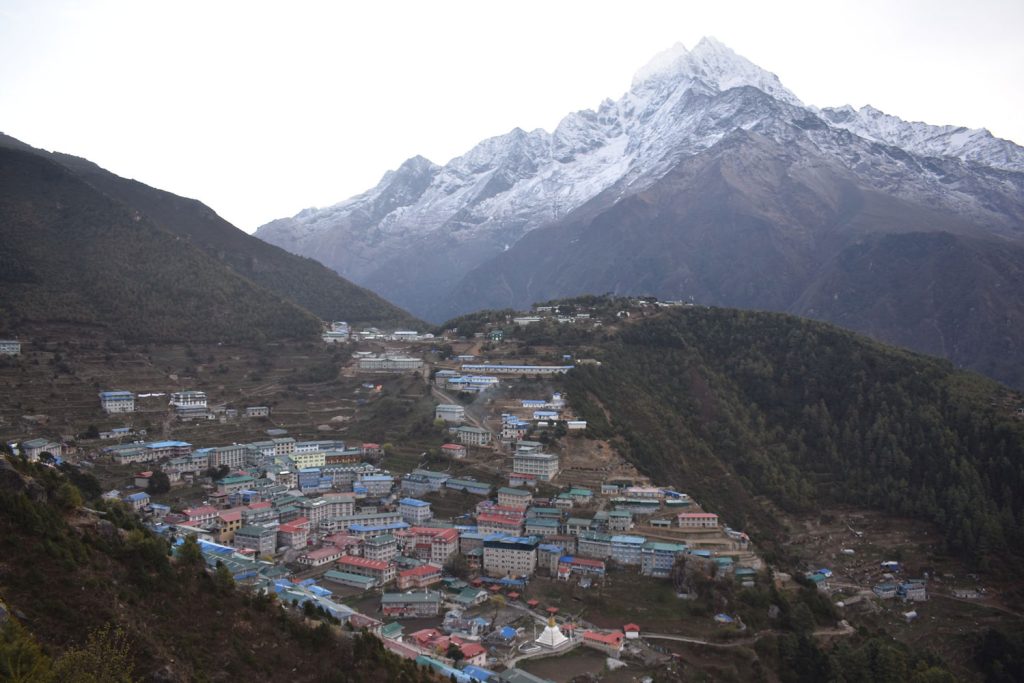
Namche Bazaar: The Gateway to Everest Base Camp
Namche Bazaar, situated in the Khumbu region of Nepal, is a popular stopping point for trekkers en route to Everest Base Camp. It is a vibrant and bustling town that serves as the gateway to the highest mountain in the world. In this section, we will explore the town of Namche Bazaar, its attractions, and its importance as the gateway to Everest Base Camp.
Description of Namche Bazaar
- Namche Bazaar is a small town situated at an altitude of 3,440 meters above sea level.
- It is located on a steep hillside overlooking the Dudh Koshi River valley.
- The town is home to several lodges, restaurants, bakeries, and shops that cater to the needs of trekkers and locals.
- The town is surrounded by beautiful mountain peaks, including Thamserku, Kangtega, and Kongde Ri.
Attractions in Namche Bazaar
- Namche Bazaar has several attractions that are worth visiting, such as the Sherpa Museum, the Namche Monastery, and the Everest View Hotel.
- The Sherpa Museum is dedicated to the history, culture, and traditions of the Sherpa people.
- The Namche Monastery is a beautiful monastery that offers stunning views of the surrounding mountains.
- The Everest View Hotel is a luxury hotel that offers breathtaking views of Mount Everest and the surrounding peaks.
Importance of Namche Bazaar as the gateway to Everest Base Camp
- Namche Bazaar is an important stopover for trekkers on their way to Everest Base Camp.
- It is the last town on the trek where trekkers can stock up on supplies and gear before heading to higher altitudes.
- Trekkers need to acclimatize to the high altitude, and Namche Bazaar offers an ideal place for rest and acclimatization.
- Namche Bazaar is also the center of Sherpa culture and serves as a hub for the Sherpa people.
In conclusion, Namche Bazaar is a must-visit destination for trekkers on their way to Everest Base Camp. It offers a unique opportunity to experience the Sherpa culture and acclimatize to the high altitude before heading to higher altitudes.

Accommodation and Facilities at Everest Base Camp
Trekking to Everest Base Camp is a once-in-a-lifetime experience that requires a lot of preparation and planning. While the trek itself is challenging, it is also an opportunity to explore the stunning landscapes of the Khumbu region, experience the local culture, and make new friends along the way.
Accommodation at Everest Base Camp
After a long and arduous trek, trekkers finally reach Everest Base Camp, which is located at an altitude of 5,364 meters. At this altitude, the air is thin, and the temperature can drop to below freezing at night. However, trekkers need not worry about accommodation as there are many tea houses and lodges available in the area.
The tea houses and lodges at Everest Base Camp offer basic but comfortable accommodation for trekkers. Most tea houses have dormitory-style rooms with shared bathrooms. However, private rooms are also available at some tea houses for those who prefer more privacy.
Facilities at Everest Base Camp
While the facilities at Everest Base Camp are basic, they are sufficient to meet the needs of trekkers. Here are some of the facilities available at Everest Base Camp:
- Electricity: Most tea houses at Everest Base Camp have electricity, which is usually generated by solar panels. However, trekkers are advised to bring their own power banks and batteries as electricity may not be available 24/7.
- Water: Trekkers can buy bottled water or refill their water bottles at the tea houses. However, they are advised to bring water purification tablets or a water filter as the water may not be safe to drink.
- Internet: Some tea houses at Everest Base Camp have Wi-Fi, but the connection may be slow and unreliable. Trekkers are advised to buy a local SIM card with a data plan for better connectivity.
- Shops: There are several shops at Everest Base Camp that sell basic supplies such as snacks, drinks, and trekking gear. Prices may be higher than in other parts of Nepal, so trekkers are advised to bring everything they need from Kathmandu or Namche Bazaar.
Conclusion
Accommodation and facilities at Everest Base Camp are basic but sufficient to meet the needs of trekkers. Trekkers can enjoy comfortable accommodation, electricity, water, and internet at the tea houses and lodges at Everest Base Camp. Additionally, they can buy basic supplies at the shops located in the area.
(open trekking bag photo with some items visible)
Packing List for Everest Base Camp Trekking
When preparing for the Everest Base Camp trek, it’s crucial to pack the right equipment and gear to ensure a safe and comfortable journey. Here is an overview of the essential items to pack:
Clothing and Footwear
- Base layers: Moisture-wicking tops and bottoms
- Insulating layers: Fleece or down jacket
- Waterproof and windproof jacket and pants
- Hiking boots with ankle support
- Hiking socks
- Hat, gloves, and scarf
- Sunglasses
Gear and Equipment
- Backpack
- Sleeping bag and liner
- Trekking poles
- Headlamp with extra batteries
- Water bottles and hydration system
- Personal first aid kit
- Sunscreen and lip balm
- Insect repellent
- Toilet paper and wet wipes
- Camera and spare batteries
- Portable charger and charging cables
Miscellaneous Items
- Cash and credit cards
- Passport and trekking permits
- Travel insurance
- Snacks and energy bars
- Binoculars
- Books and games
When packing, keep in mind the weight limit for flights to and from Lukla, which is 15kg (33lbs) for checked baggage and 5kg (11lbs) for carry-on. It’s also recommended to pack in layers to adjust to changing weather conditions during the trek. Don’t forget to leave some space in your backpack for souvenirs and other items you might pick up during the trek.
Remember, it’s important to pack only what you need and to avoid overpacking to prevent unnecessary strain on your back and knees. Keep your backpack weight within your physical limits to make your trek enjoyable and comfortable.
Altitude Sickness and Safety Tips
Altitude sickness is a serious concern for trekkers who are planning to hike to the Everest Base Camp. As you ascend higher, the air pressure decreases, and the air becomes thinner, which can lead to altitude sickness. It’s important to be aware of the symptoms and take preventive measures to avoid altitude sickness during the trek. Here are some tips for staying safe during your Everest Base Camp trek:
Altitude Sickness and its Symptoms
Altitude sickness, also known as acute mountain sickness (AMS), is caused by a lack of oxygen in the body at high altitudes. The symptoms of altitude sickness include:
- Headache
- Nausea and vomiting
- Dizziness
- Shortness of breath
- Loss of appetite
- Fatigue
- Trouble sleeping
If you experience any of these symptoms, it’s important to take immediate action to prevent the condition from getting worse.
Tips for Acclimatization and Prevention of Altitude Sickness
To avoid altitude sickness, it’s important to take time to acclimatize as you ascend higher. Here are some tips for acclimatization and prevention of altitude sickness:
- Ascend gradually and take rest days at regular intervals
- Stay hydrated by drinking plenty of water
- Avoid alcohol and smoking
- Eat a balanced diet with enough calories to sustain the trek
- Take medication to prevent altitude sickness if necessary, under the guidance of a doctor
Safety Tips for Trekking to Everest Base Camp
Trekking to Everest Base Camp can be challenging and dangerous if proper safety precautions are not taken. Here are some safety tips to keep in mind during the trek:
- Always trek with a guide or a group
- Carry a first-aid kit and know how to use it
- Dress appropriately for the weather conditions and wear sturdy hiking boots
- Keep yourself warm and dry to prevent hypothermia
- Follow the instructions of your guide and pay attention to the weather conditions
- Be prepared for emergencies and carry a satellite phone or a communication device
By following these safety tips and taking preventive measures for altitude sickness, you can have a safe and enjoyable trekking experience to the Everest Base Camp.
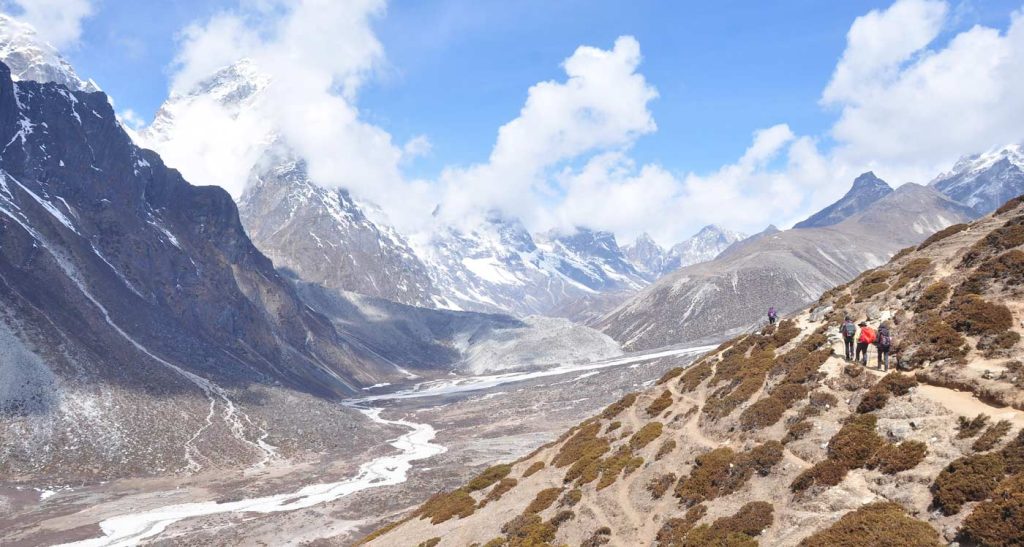
Hiring Porters for the Namche Bazaar to Everest Base Camp Trek
The Namche Bazaar to Everest Base Camp trek is a challenging journey that requires a lot of physical exertion. Carrying a heavy load of equipment and supplies can be daunting, and that’s where hiring porters comes in. Porters are experienced locals who can carry your luggage and supplies, allowing you to focus on the trek itself. Here’s what you need to know about hiring porters for the trek:
How to hire a porter for ebc trek:
- Contact a trekking agency: Most trekking agencies in Kathmandu and Namche Bazaar offer porter services. You can contact them via email or phone to arrange the hiring.
- Discuss your requirements: Let the agency know how much luggage you have, and how many porters you need. They will provide you with a quote based on the distance and duration of the trek.
- Meet the porters: Once you arrive in Namche Bazaar, you will meet your porters. You can discuss the details of the trek with them, such as how many hours you will walk each day and where you plan to stay overnight.
Pre-Booking and Availability of porters for everest base camp trek:
Porters are readily available in Namche Bazaar and Kathmandu. However, it’s important to book them in advance during peak season (March to May and September to November) as they get booked up quickly.
Cost of hiring a porter for the namche to ebc trek:
The cost of hiring a porter for the Namche Bazaar to Everest Base Camp trek can vary depending on the season and duration of the trek. On average, you can expect to pay around USD $20-25 per day per porter, which includes their meals, accommodation, and insurance. You will also need to cover the cost of their transportation to and from the starting point of the trek.
Suggestions:
- Choose a reputable trekking agency: It’s important to choose a reputable agency to ensure that you get experienced and reliable porters.
- Pack light: While porters can carry a considerable amount of weight, it’s still important to pack light. Keep in mind that the weight limit per porter is typically 30 kg.
- Be respectful: Porters are an essential part of the trekking experience, and they work hard to make your journey comfortable. Be respectful and kind to them throughout the trek.
Hiring porters can make the Namche Bazaar to Everest Base Camp trek more enjoyable and less challenging. With the help of experienced locals, you can focus on the breathtaking views and the adventure of a lifetime.
Conclusion
After exploring the Namche Bazaar to Everest Base Camp trekking route, it’s clear to see why it’s such a popular choice among trekkers. The stunning views of Mount Everest and the surrounding Himalayan mountains, the unique cultural experiences in the villages along the way, and the sense of accomplishment upon reaching the base camp make it a truly unforgettable journey.
Summary and Key Takeaways
To summarize, in this article we covered:
- The importance of the Namche Bazaar to Everest Base Camp trekking route
- Information on the permits required for the trek and their cost
- Overview of the Everest Base Camp trekking packages and what they include
- Difficulty level of the trek and tips for preparation and training
- Description of Namche Bazaar and its attractions
- Accommodation and facilities available at Everest Base Camp
- Information on altitude sickness and safety tips for the trek
Final Thoughts
Embarking on the Namche Bazaar to Everest Base Camp trekking route is a once-in-a-lifetime adventure that requires careful planning, preparation, and training. However, with the right mindset and guidance from experienced guides and tour agencies, anyone can accomplish this feat. It’s a journey that will test your physical and mental strength, but the rewards are well worth it. So why not take the leap and start planning your EBC trekking trip today?


